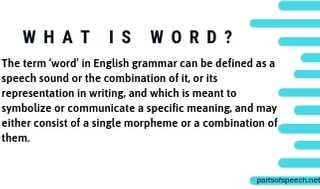What is Word in English Grammar? [PDF]
In this lesson, we are going to see what is a word in English Grammar with some Syntax and Morphology! So let’s dive into the lesson.

People study the English language in great depth, but only a few of them (if any) take time to understand the term ‘word’. That’s because it’s widely assumed that it’s something people understand by default.
Ask anyone about an example of a word, and they’ll have all the examples in the world to recite.
At first glance, you may come up with as many examples as it’s humanly possible of all the things that unmistakably constitute a ‘word. For instance, you, some, hers, riches, mine, leg, air, mind, of, I, at, me, in, here, and an endless string of other similar examples.
So, What Exactly is a Word?
The term ‘word’ in English grammar can be defined as a speech sound or the combination of it, or its representation in writing, and which is meant to symbolize or communicate a specific meaning, and may either consist of a single morpheme [External Link] or a combination of them.
The study of word structures, on the other hand, is what is referred to as word morphology in Linguistics, while the study of word meanings is referred to as lexical semantics.
Word can also be defined as the smallest unit of grammar, separated by spaces when written and pauses when spoken, and which can stand on its own as a complete expression.

Syntax and Morphology
In grammar, the term ‘word’ encapsulates two crucial components – and that is Syntax and morphology.
The two-division stem out of the special status of the term word in linguistics, which identifies it as the basic grammar unit.
In which case, syntax addresses that part where words can be combined with each other to formulate a sentence, while morphology takes a deeper look into the form of the word itself.
Suffice it to say that the study of words is NOT something easy. The more you look at the term word, and break it, the more things get murkier in the field of linguistics.
So, How are Words Put Together?
There’re two ways in which words can be put together and they include:
- Inflection.
- Word Formation.
Inflection
Once a new word is brought into being, it automatically takes varied forms and intensities. Simply put, the word can be broken down to mean different things and even communicate in varying intensities.
Examples
- iPad iPads.
- Big bigger biggest.
- Smart smarter smartest.
Word Formation
This is where two different words are joined to form and new word.
Examples include:
- Basket and ball combined to form the word basketball.
- House and wife combined to form the word housewife.
The negative in- combined with dispensable to form the word indispensable.
In the last example, the word in- has been added to dispensable to come up with a word that means the exact opposite of the term dispensable.
This is called negation and it’s one of the ways negative words [External Link] are formed in English.
More examples:
- In- + vertebrates = invertebrates.
- In- + experience = inexperience.
- In- + adequate = inadequate.
When the additions are featured at the front of a word, they’re called prefixes and when they’re featured at the rear end of a word they’re referred to as suffixes. Examples of Prefixes and suffixes:
Prefixes examples
- Dethrone, Declutter, Detach.
- Disapprove, Disinherit, Disown.
- Handbag, handheld, handgun.
- Illegible, illegitimate, illegal, illiterate.
Suffixes examples
- American, Canadian, Chinese, Nigerian, Japanese, Croatian.
- Larger – largest, bigger – Biggest, Taller – Tallest.
- Workaholic, alcoholic, chocoholic.
- Malleable, Dateable, Agreeable.
- Classy, messy, sassy.
- Started, married, robbed.
Putting Words Together to Form a Sentence
Words are normally put together to create long stretches of the English language. They’re what forms a sentence that ends up conveying a specific message that can be understood by the targeted reader.
The English language [External Link] has a lot of freedom. While writing and the text is developing, as a writer you’re at liberty to select any lexical item that strikes your fancy, provided it’s grammatically correct.
This is what’s widely referred to as the “open choice principle” in linguistics, where a flowing grammatical unit, a phrase or clause presents a far-reaching range of options that a writer or speaker is at liberty to choose from.
However, this is NOT always the case in the English language. As you’re soon to find out, many words have a limited list of options.
That’s because, a certain group of lexical items tends to appear together, and that’s what is referred to as collocation in Linguistics, while the corresponding lexical items are referred to as collocates.
For instance, when someone talks about “the moment of”, the next thing that comes to mind is “truth.” That’s because “the moment of” and “truth” tend to go together. That makes them each other’s collocates, while the process of putting them together is referred to as collocation.
A Must Watch Video Lesson on Word:
[x_video_embed][/x_video_embed]
This lesson all about Word in English grammar, I hope you have able to understand the lesson, if you have any doubts feel free to comment down below.
References [External Links]:
- Words in English: Types of Word Formation – Rice University
- How New Words Are Created – The History of English